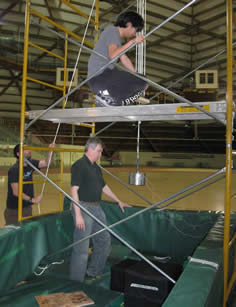
One of the most important features at this fall’s Olympic Speedskating Trials and World Cup competition will go unnoticed by many spectators, but you can bet the athletes will appreciate it, especially after an unfortunate fall. The padding on the boards surrounding the rink is their safety net. It acts as a cushioned buffer to reduce the risk of injury by absorbing the impact of skaters sliding out of control after reaching top speeds of up to 30 miles per hour. But before the padding is installed, it must meet rigorous performance standards set by the International Skating Union.
The NMU Physics department took advantage of an invitation to assist the U.S. Olympic Education Center and Jacquart Fabric Products of Ironwood in testing a new set of pads for the upcoming short-track events. Jacquart had produced the original pads for the USOEC more than 20 years ago.
“This is simple physics at work, but it sounds easier to accomplish than it is in terms of setup,” said Dave Lucas (Physics) during one of the test sessions in the Superior Dome. “We’re approaching it almost in a Rube Goldberg way. The end result looks crude, but it gets the job done. We’re happy with how the testing is going.”
Lucas and three NMU students dropped a cylindrical mass—machined on campus by Cale Polkinghorne (Engineering Technology)—from one, two, three and four meters in the air onto the pad. An accelerometer measured the force of impact while Dave Donovan (Physics) monitored the computer data it generated to compare the minimum-standard pad with the new pad. "We bought two accelerometers to make sure we get consistent results," Lucas added. "These are heavily used in mechanical engineering and physics testing. The company that sold these actualy used them to test explosives. Obviously the forces we're dealing with are lower. We will get additional use out of these in the department in the instrumentation and analysis class Dr. Donovan teaches for our majors and for other purposes."
According to Jeff Kleinschmidt (USOEC), the initial tests identified a combination of materials that exceeded the standard set by the International Skating Union, but Jacquart has revised its original design and will conduct additional tests this week in search of a more cost-effective option. "The materials included both memory foam and standard foam, which costs less," he added. "The testing determined that eight inches of memory foam exceeds the standard, but four does not. The question now is where in that range is the right combination that exceeds the standard most cost-effectively." |


 Physics Helps Test Speedkskating Pads
Physics Helps Test Speedkskating Pads 